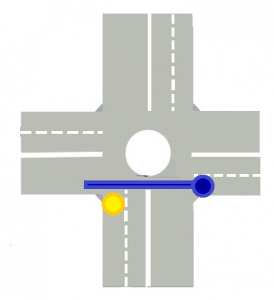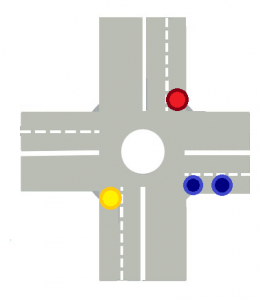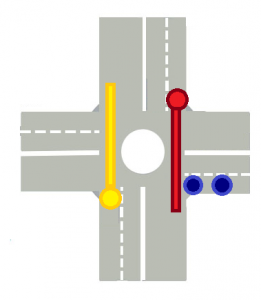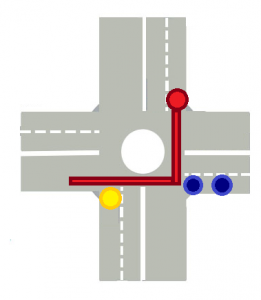Learning to Drive: Roundabouts (2/2)
2021-12-03
Part 2 of our Learning to Drive series on Roundabouts.
If you missed Part 1, we suggest you catch up now.
Learning to Drive: Roundabout Advice
Wrong Lane
In our last post, we finished off talking about lane etiquette. If you’ve selected the wrong lane, you should stay in it until it is safe to change lanes – remember to follow your MSM routine.
Blocker Cars
Like with all roads, you should aim to make progress at roundabouts and not hold up the flow of traffic behind you. That can be difficult when you have to give way to cars coming from the right.
If you’ve been waiting at a roundabout for a long time, you should make use of what we like to call ‘Blocker Cars‘.
What is a Blocker Car? When a new car enters a roundabout, they immediately gain priority over cars to their left. This ‘blocks’ them and gives other cars, waiting at other exits, an opportunity to enter.
Here are some visuals to help explain.
The Yellow car wants to take the road ahead, but the Blue cars have priority. So the Yellow has to wait.

But what’s this? A Red car appears and wants to enter the Roundabout. This means the Blue cars have to wait for the Red car to pass.

Now because the Blue cars have to wait, the Yellow car can enter the Roundabout.

When waiting at a Roundabout, don’t just look immediately to your right. You should survey the entire roundabout to find a ‘Blocker Car’.
However be quick, as ‘Blocker Cars’ can also work against you. How?
In the previous example, the Red car used the road ahead and did not use an exit that would cause it to cross the path of the Yellow car. This meant the Yellow car had nobody to give way to.

However, if the Red Car wanted to use an exit after the road ahead (e.g. the 3rd exit) it would cause the Red car to cross the path of the Yellow car.
Unless the driver of the Yellow car acts quickly, they will have to give way to the Red car.
So – once you have a safe opportunity to enter the roundabout, do so.
When you’re learning to drive, your instructor will not rush you to enter the roundabout.
As you get more experienced, you should be able to confidently enter a roundabout and make use of ‘Blocker Cars’.
PERFECT ROUNDABOUT TECHNIQUE
After reading parts 1 and 2, you’re ready to take on roundabouts. So here is the perfect procedure for tackling most roundabouts.
- Before reaching the roundabout, check your centre mirror, to observe traffic behind you.
- Look out for any signs / road markings telling you where to position the car.
- If you need to position yourself in a certain lane, check your left / right wing mirror & blind spot before indicating and manoeuvring into that lane.
- Begin to survey the roundabout and assess whether it is safe to enter without stopping, or if you will have to wait.
- Slow down to about 5-10 mph.
- If safe to enter without stopping, follow the roundabout round, in the lane you’ve selected. If traffic is approaching from the right, stop and set the biting point.
- When traffic is clear from the right and you have a safe space to enter the roundabout, do so.
- Follow the roundabout round and remain in lane.
- Try to enter 2nd gear before circling the roundabout.
- When you wish to exit, check your centre mirror, left wing mirror and left blind spot; indicate left.
- If safe, indicate left and exit the roundabout. Continue on and match the speed of traffic.
LEAST MEMORABLE STEP
Checking For Blockers – you may forget to look for blockers.
MOST MEMORABLE STEP
Giving Way – You will not want to pull out unsafely, it’s the fast track to test failure.
InsureLearnerDriver HELPFUL TIP
Try to put the car in 2nd gear before you begin circling the roundabout. It is hard and potentially dangerous to do so whilst circling.
Mini Roundabouts
The technique used for mini roundabouts is more or less the same as big roundabouts. This video will cover some of the more minor differences about using mini roundabouts.
< Read Part 9 – Roundabouts (1/2) Read Part 10 – Emergency Stops>
Learning to Drive’ series – full lesson list
- Cockpit Drill
- Moving Off & Pulling Over
- Approaching Junctions
- Emerging at Junctions
- Meeting Traffic
- Making Progress
- Hazard Awareness
- Pedestrian Crossings
- Roundabouts (1/2)
- Emergency Stops
- Dual Carriageways
- Turn In The Road
- Reverse Bay Park
- Reverse Around a Corner
- Reverse Parallel Park
- Show me, Tell me

